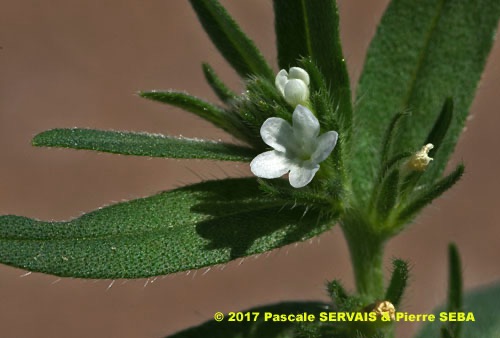
Buglossoides arvensis (L.) I.M.Johnst.
Fam. : Boraginaceae
© Pascale SERVAIS & Pierre SEBA, 2018. Tilo Botanica: Flore de Tilos et du Dodécanèse / Flora of Tilos and of the Dodecanese
English translation by Brenda Bradbury, Howard Bradbury and Stéphane Léonard
Plante herbacée, hermaphrodite, à tige érigée à étalée, souvent solitaire, poilue, peu ramifiée.
Feuilles alternes, simples, entières, linéaires à oblongues, couvertes de poils appliqués et raides, généralement dressées, sans stipules.
Fleurs à symétrie radiaire, blanches, de 5 mm de diamètre, réunies en cyme solitaire de 1 cm, rapidement lâche. 5 étamines à filet très court, soudées à la corolle. Corolle à 5 pétales soudés en tube glabre à l’intérieur et poilu à l’extérieur. Calice à 5 sépales verts, libres, hérissés de poils, à peine dépassés par la corolle. Ovaire supère.
Fruits, akènes bruns, durs, verruqueux, aigus au sommet, insérés à la base du calice persistant.
___________________________
Plant herbaceous, hermaphrodite. Stem erect to spread out, often solitary, hairy, not very branched.
Leaves alternate, simple, entire, linear to oblong, covered in appressed and stiff hairs, generally erect, without stipules.
Flowers radially symmetrical, white, 5 mm in diameter, joined together in solitary cyme of 1 cm, quickly loose. 5 stamens with a very short filament, fused with the corolla. Corolla with 5 petals fused in tube, glabrous inside and hairy outside. Calyx with 5 green free sepals, covered in hairs, scarcely exceeded by the corolla. Ovary superior.
Fruits, brown, tough, verrucose achenes, acute at the top, inserted into the base of the persistent calyx.
Descripteurs / Identifying features
1
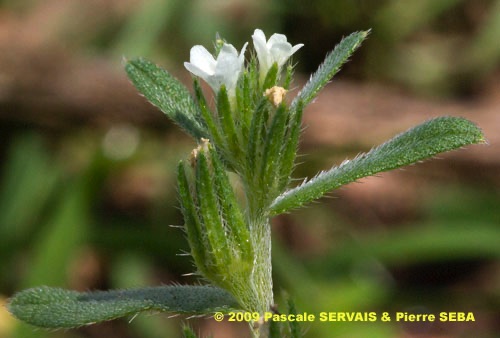
2
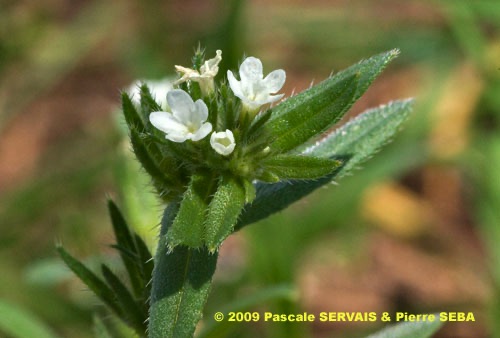
3
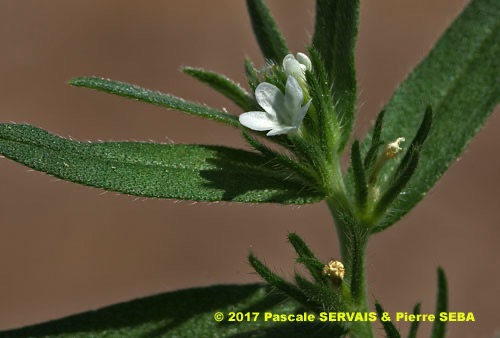
4
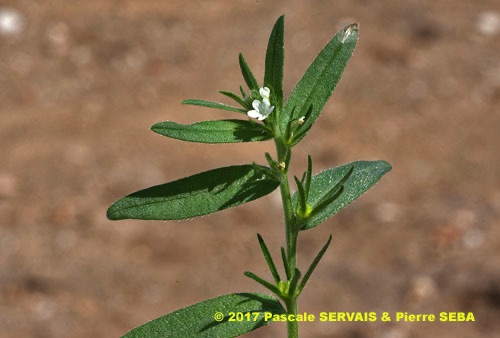
5
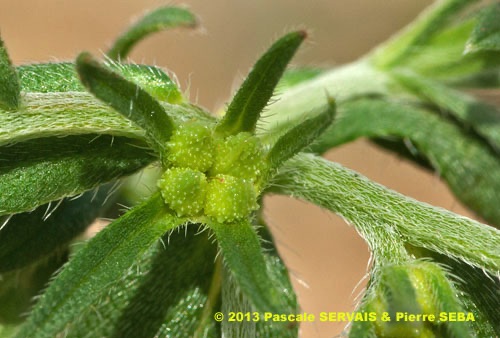
6
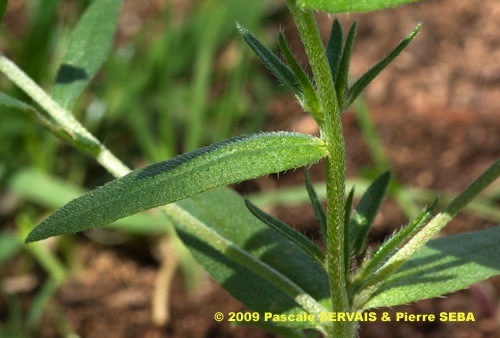
7
Étymologie / Etymology :
Buglossoides : emprunt du latin buglossa, -ae (nom) = le buglosse, forme
latinisée du grec ancien βούγλωσσος [ < βοῦς, βοός (nom) = le bœuf,
la vache + γλῶσσα, -ης (nom) = la langue ] = qui a la forme d’une
langue de bœuf, nom donné à une plante par Pline, naturaliste latin
mort en 79 apr. J.-C., en référence à la forme des feuilles.
Buglossoides [ < buglossa = le buglosse + εἶδος, -ους (nom)
= l’apparence, l’aspect ] = qui a l’apparence du buglosse, qui
ressemble au buglosse.
Arvensis : adjectif créé par les botanistes [ < arvum, -i (nom)
= le champ cultivé ] = qui pousse dans les champs cultivés.
Buglossoides : borrowed from Latin buglossa, -ae (noun) = bugloss,
Latinized form of the Classical Greek βούγλωσσος [ < βοῦς, βοός
(noun) = ox, cow + γλῶσσα, -ης (noun) = tongue ] = which has the
form of a beef tongue, name given to a plant by Plinius, Latin naturalist
died in 79 AD, referring to the shape of the leaves.
Buglossoides [ < buglossa = bugloss + εἶδος, -ους (noun)
= appearance, aspect ] = which has the appearance of bugloss,
resembling bugloss.
Arvensis : adjective created by botanists [ < arvum, -i (noun)
= field, cultivated land ] = which grows in cultivated fields.
Synonymes / Synonyms :
Lithospermum arvense L.
Aegonychon arvense (L.) Gray
Lithospermum calycinum Wettst.
Lithospermum czernjaevii Klokov & Des.-Shost.
Lithospermum medium Chevall.
Lithospermum rochelii Friv.
Lithospermum sylvestre Bubani
Margarospermum arvense (L.) Decne.
Rhytispermum arvense (L.) Link
Rhytispermum medium (Chevall.) Fourr.
Noms vernaculaires / Common names :
Noms français / French names :
Buglosse des champs — Charée — Grémil des champs.
Nom grec / Greek name :
Λιθόσπερμο.
Noms anglais / English names :
Corn gromwell — Field gromwell — Pigeonweed.
Nom allemand / German name :
Acker-Steinsame.
Noms espagnols / Spanish names :
Cornicabra — Mijo de sal.
Noms italiens / Italian names :
Erba perla minore dei campi — Erba-perla minore —
Strigolo selvatico.
Habitat :
Cultures - Lieux pierreux - Lieux incultes - Chemins.
Cultivated places - Stony places - Waste ground - Waysides.
Île / Island :
Tilos.
Hauteur / Height range :
De 5 cm à 50 cm.
From 5 cm to 50 cm.
Floraison / Flowering time :
De janvier à avril.
From January to April.
Groupe / Classification :
Dicotylédones.
Dicotyledons.
Pérennité / Lifespan :
Annuelle.
Annual.
Description :
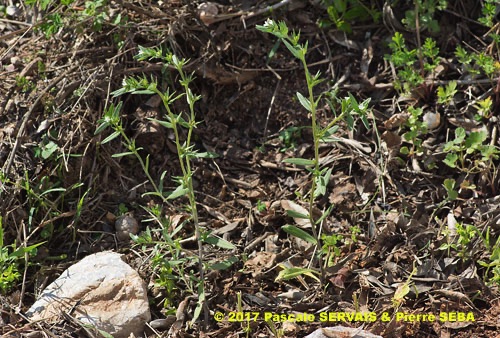
8
Photo 1 :
Localisation / Location : Tilos, Megalochorio, Plaine d’Erystos
Date : 17/03/2017
GPS : Lat. 36,44631° N / Long. 27,34956° E / Alt. 27 m
Type : Photographie numérique / Digital Photograph (24 mégapixels)
Photo 2 :
Localisation / Location : Tilos, Megalochorio, Chemin de Skafi
Date : 27/03/2009
GPS : Lat. 36,45544° N / Long. 27,35002° E / Alt. 58 m
Type : Photographie numérique / Digital Photograph (10 mégapixels)
Photo 3 :
Localisation / Location : Tilos, Megalochorio, Chemin de Skafi
Date : 27/03/2009
GPS : Lat. 36,45544° N / Long. 27,35002° E / Alt. 58 m
Type : Photographie numérique / Digital Photograph (10 mégapixels)
Photo 4 :
Localisation / Location : Tilos, Megalochorio, Plaine d’Erystos
Date : 17/03/2017
GPS : Lat. 36,44631° N / Long. 27,34956° E / Alt. 27 m
Type : Photographie numérique / Digital Photograph (24 mégapixels)
Photo 5 :
Localisation / Location : Tilos, Megalochorio, Plaine d’Erystos
Date : 17/03/2017
GPS : Lat. 36,44631° N / Long. 27,34956° E / Alt. 27 m
Type : Photographie numérique / Digital Photograph (24 mégapixels)
Photo 6 :
Localisation / Location : Tilos, Megalochorio, Grotte des éléphants, Environs
Date : 22/01/2013
GPS : Lat. 36,44135° N / Long. 27,36293° E / Alt. 103 m
Type : Photographie numérique / Digital Photograph (10 mégapixels)
Photo 7 :
Localisation / Location : Tilos, Megalochorio, Chemin de Skafi
Date : 27/03/2009
GPS : Lat. 36,45544° N / Long. 27,35002° E / Alt. 58 m
Type : Photographie numérique / Digital Photograph (10 mégapixels)
Photo 8 :
Localisation / Location : Tilos, Megalochorio, Plaine d’Erystos
Date : 17/03/2017
GPS : Lat. 36,44631° N / Long. 27,34956° E / Alt. 27 m
Type : Photographie numérique / Digital Photograph (24 mégapixels)

Google Maps
Google Maps
Google Maps
Google Maps
Google Maps
Google Maps
Google Maps
Google Maps